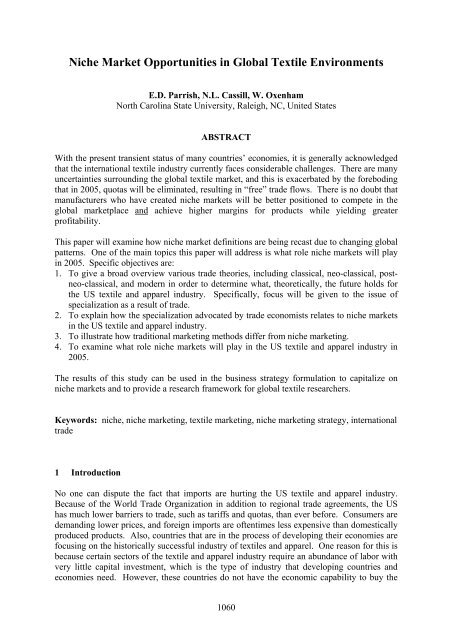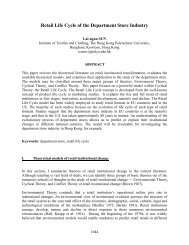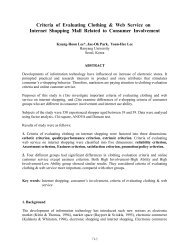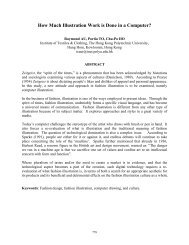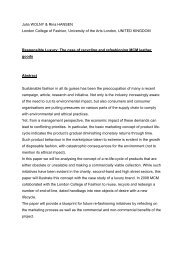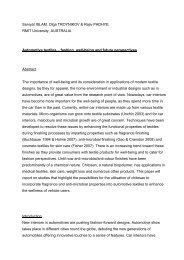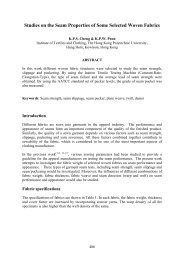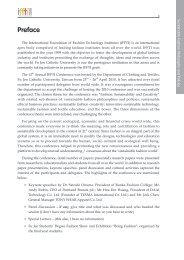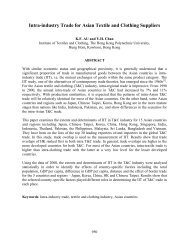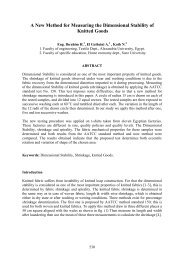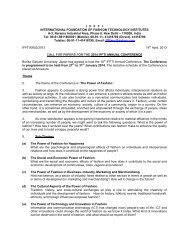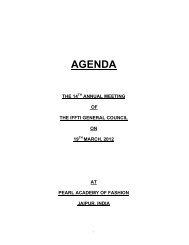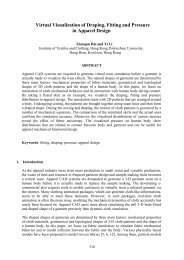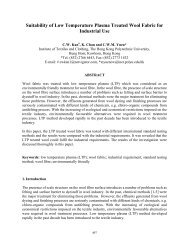Niche Market Opportunities in Global Textile Environments
Niche Market Opportunities in Global Textile Environments
Niche Market Opportunities in Global Textile Environments
Create successful ePaper yourself
Turn your PDF publications into a flip-book with our unique Google optimized e-Paper software.
<strong>Niche</strong> <strong>Market</strong> <strong>Opportunities</strong> <strong>in</strong> <strong>Global</strong> <strong>Textile</strong> <strong>Environments</strong><br />
E.D. Parrish, N.L. Cassill, W. Oxenham<br />
North Carol<strong>in</strong>a State University, Raleigh, NC, United States<br />
ABSTRACT<br />
With the present transient status of many countries’ economies, it is generally acknowledged<br />
that the <strong>in</strong>ternational textile <strong>in</strong>dustry currently faces considerable challenges. There are many<br />
uncerta<strong>in</strong>ties surround<strong>in</strong>g the global textile market, and this is exacerbated by the forebod<strong>in</strong>g<br />
that <strong>in</strong> 2005, quotas will be elim<strong>in</strong>ated, result<strong>in</strong>g <strong>in</strong> “free” trade flows. There is no doubt that<br />
manufacturers who have created niche markets will be better positioned to compete <strong>in</strong> the<br />
global marketplace and achieve higher marg<strong>in</strong>s for products while yield<strong>in</strong>g greater<br />
profitability.<br />
This paper will exam<strong>in</strong>e how niche market def<strong>in</strong>itions are be<strong>in</strong>g recast due to chang<strong>in</strong>g global<br />
patterns. One of the ma<strong>in</strong> topics this paper will address is what role niche markets will play<br />
<strong>in</strong> 2005. Specific objectives are:<br />
1. To give a broad overview various trade theories, <strong>in</strong>clud<strong>in</strong>g classical, neo-classical, postneo-classical,<br />
and modern <strong>in</strong> order to determ<strong>in</strong>e what, theoretically, the future holds for<br />
the US textile and apparel <strong>in</strong>dustry. Specifically, focus will be given to the issue of<br />
specialization as a result of trade.<br />
2. To expla<strong>in</strong> how the specialization advocated by trade economists relates to niche markets<br />
<strong>in</strong> the US textile and apparel <strong>in</strong>dustry.<br />
3. To illustrate how traditional market<strong>in</strong>g methods differ from niche market<strong>in</strong>g.<br />
4. To exam<strong>in</strong>e what role niche markets will play <strong>in</strong> the US textile and apparel <strong>in</strong>dustry <strong>in</strong><br />
2005.<br />
The results of this study can be used <strong>in</strong> the bus<strong>in</strong>ess strategy formulation to capitalize on<br />
niche markets and to provide a research framework for global textile researchers.<br />
Keywords: niche, niche market<strong>in</strong>g, textile market<strong>in</strong>g, niche market<strong>in</strong>g strategy, <strong>in</strong>ternational<br />
trade<br />
1 Introduction<br />
No one can dispute the fact that imports are hurt<strong>in</strong>g the US textile and apparel <strong>in</strong>dustry.<br />
Because of the World Trade Organization <strong>in</strong> addition to regional trade agreements, the US<br />
has much lower barriers to trade, such as tariffs and quotas, than ever before. Consumers are<br />
demand<strong>in</strong>g lower prices, and foreign imports are oftentimes less expensive than domestically<br />
produced products. Also, countries that are <strong>in</strong> the process of develop<strong>in</strong>g their economies are<br />
focus<strong>in</strong>g on the historically successful <strong>in</strong>dustry of textiles and apparel. One reason for this is<br />
because certa<strong>in</strong> sectors of the textile and apparel <strong>in</strong>dustry require an abundance of labor with<br />
very little capital <strong>in</strong>vestment, which is the type of <strong>in</strong>dustry that develop<strong>in</strong>g countries and<br />
economies need. However, these countries do not have the economic capability to buy the<br />
1060
textile and apparel products <strong>in</strong> which they produce, and therefore, must f<strong>in</strong>d suitable export<br />
markets. Due to the fact that the US has significant purchas<strong>in</strong>g power per capita, the US is a<br />
highly desirable market for these products.<br />
These factors, comb<strong>in</strong>ed with lower trade restrictions, have left the US textile and apparel<br />
<strong>in</strong>dustry very vulnerable to imports. Even with tariffs and quotas lower than anytime <strong>in</strong> recent<br />
history, the US textile market is still one of the most protected <strong>in</strong> the country. Yet <strong>in</strong> 2005,<br />
quotas will be elim<strong>in</strong>ated result<strong>in</strong>g <strong>in</strong> “free” trade. This will only exacerbate the problems<br />
currently fac<strong>in</strong>g the US textile and apparel <strong>in</strong>dustry due to lower priced imports. In the past<br />
few years, even with a relatively protected market, many of the US textile “giants” have<br />
declared bankruptcy, <strong>in</strong>clud<strong>in</strong>g Burl<strong>in</strong>gton Industries, Malden Mills, CMI Industries, and<br />
Galey & Lord, while others are overhaul<strong>in</strong>g their bus<strong>in</strong>ess practices and look<strong>in</strong>g for other<br />
markets <strong>in</strong> which they will be more competitive. One way <strong>in</strong> which companies are do<strong>in</strong>g this<br />
is by identify<strong>in</strong>g and exploit<strong>in</strong>g potential niche markets. Figure 1.1 illustrates the progression<br />
from commodity markets to niche markets for the US textile and apparel <strong>in</strong>dustry.<br />
Theoretically, the decl<strong>in</strong>e of the US textile and apparel <strong>in</strong>dustry is expected, however<br />
traditional trade theories endorse specialization, or to a greater degree of specialization, niche<br />
markets, as a result of trade. This paper will focus on this issue.<br />
Basic Commodity Products and Processes<br />
•Broad Cloth<br />
•Cut and Sew<br />
Capital and Technologically Intensive<br />
Products<br />
•Yarn Formation<br />
•Dye<strong>in</strong>g and F<strong>in</strong>ish<strong>in</strong>g<br />
<strong>Niche</strong> <strong>Market</strong>s<br />
•Industrial <strong>Textile</strong>s<br />
•Medical <strong>Textile</strong>s<br />
Figure 1.1: Progression from commodity markets to niche markets for the US textile and apparel<br />
<strong>in</strong>dustry<br />
In addition to this, the research objectives of this paper are:<br />
5. To give a broad overview various trade theories, <strong>in</strong>clud<strong>in</strong>g classical, neo-classical, postneo-classical,<br />
and modern <strong>in</strong> order to determ<strong>in</strong>e what, theoretically, the future holds for<br />
the US textile and apparel <strong>in</strong>dustry. Specifically, focus will be given to the issue of<br />
specialization as a result of trade.<br />
6. To expla<strong>in</strong> how the specialization advocated by trade economists relates to niche markets<br />
<strong>in</strong> the US textile and apparel <strong>in</strong>dustry.<br />
7. To illustrate how traditional market<strong>in</strong>g methods differ from niche market<strong>in</strong>g.<br />
8. To exam<strong>in</strong>e what role niche markets will play <strong>in</strong> the US textile and apparel <strong>in</strong>dustry <strong>in</strong><br />
2005.<br />
1061
Economists agree that, theoretically, <strong>in</strong> <strong>in</strong>ternational trade some <strong>in</strong>dustries are “w<strong>in</strong>ners”<br />
while others are “loser”. At the current rate, the US textile and apparel <strong>in</strong>dustry is on its way<br />
to becom<strong>in</strong>g a “loser”. This paper focuses on why trade theories lead to this conclusion, but<br />
also how the US textile and apparel <strong>in</strong>dustry can ga<strong>in</strong> a comparative advantage 1 <strong>in</strong> addition to<br />
a competitive advantage 2 by us<strong>in</strong>g the trade theories to their benefit through specialization,<br />
and as an extension, niche markets.<br />
2 Review of Economic Trade Theories<br />
2.1 Classical Trade Theory<br />
In the early 19 th century, David Ricardo developed the idea that trade patterns between<br />
countries should be based not on absolute efficiency but on relative efficiency. This came as<br />
an augmentation to Adam Smith’s theory of absolute advantage from the 18 th century. Smith<br />
believed that certa<strong>in</strong> countries could produce certa<strong>in</strong> goods more efficiently than others could<br />
and that the advantage was absolute. A country should export those products <strong>in</strong> which it has<br />
an absolute advantage, and imports those products <strong>in</strong> which it does not. If a country had an<br />
absolute advantage <strong>in</strong> all <strong>in</strong>dustries, then that country should not trade [3]. Ricardo, on the<br />
other hand, believed that a country only has to have a relative advantage to benefit from trade.<br />
In his theory, relative advantage is determ<strong>in</strong>ed by the relative productivity of labor. In The<br />
Pr<strong>in</strong>ciples of Political Economy and Taxation (1911), Ricardo uses an example illustrat<strong>in</strong>g<br />
England’s production of cloth and Portugal’s production of w<strong>in</strong>e. He supposes that England<br />
has an absolute advantage compared to Portugal <strong>in</strong> the production of cloth and w<strong>in</strong>e, but her<br />
advantage is greater <strong>in</strong> the production of cloth. However, Portugal relative disadvantage <strong>in</strong><br />
the production of w<strong>in</strong>e is less than her disadvantage <strong>in</strong> the production of cloth. Therefore,<br />
England should export cloth to Portugal and import w<strong>in</strong>e from Portugal. Ricardo (1911)<br />
stated that:<br />
Though she [Portugal] could make the cloth with the labour of 90 men, she<br />
would import it from a country where it required the labour of 100 men to<br />
produce it, because it would be advantageous to her rather to employ her<br />
capital <strong>in</strong> the production of w<strong>in</strong>e, for which she would obta<strong>in</strong> more cloth from<br />
England, than she could produce by divert<strong>in</strong>g a portion of her capital from the<br />
cultivation of v<strong>in</strong>es to the manufacture of cloth (p. 82).<br />
In his writ<strong>in</strong>gs, Ricardo never uses the term comparative advantage. Economists, as a<br />
summation of his theory, developed this term, as well as the mathematical theorem that is<br />
used <strong>in</strong> the test<strong>in</strong>g of this theory. Equation 2.1 is the standard theorem of comparative<br />
advantage.<br />
(Q 1 /L 1 ) > (Q 2 /L 2 )<br />
(Q 1 /L 1 )* (Q 2 /L 2 )*<br />
Equation 2.1: Theorem of Comparative Advantage<br />
Source: Bhagwati, J., Panagariya, A., & Sr<strong>in</strong>ivasan, T.N., (1998), Lectures on International Trade, 2 nd ed.,<br />
Cambridge, Massachusetts: The MIT Press.<br />
In this equation, Q 1 is the output of good 1, L 1 is the labor <strong>in</strong>put of good 1, Q 2 is the output of<br />
good 2, and L 2 is the <strong>in</strong>put of good 2 (* <strong>in</strong>dicates the world price). This theorem states that<br />
1 Comparative advantage is a central concept <strong>in</strong> economic trade theory which states that “a country (or any geographical<br />
area) should specialize <strong>in</strong> produc<strong>in</strong>g and export<strong>in</strong>g those products <strong>in</strong> which it has a comparative, or relative cost, advantage<br />
compared with other countries and should import those goods <strong>in</strong> which it has a comparative disadvantage”. [1]<br />
2 Competitive advantage refers to “whatever it is that enables a firm to beat its competition <strong>in</strong> the marketplace”. [2]<br />
1062
when the ratio of the price of Q 1 to the world price of Q 1 * is greater than the ratio of the price<br />
of Q 2 to the world price of Q 2 *, then the country should produce and specialize <strong>in</strong> Q 1 . In<br />
other words, countries will tend to specialize <strong>in</strong> those products <strong>in</strong> which they enjoy low<br />
relative costs.<br />
Ricardo’s theory of comparative advantage is a core concept <strong>in</strong> the theory of <strong>in</strong>ternational<br />
trade and has been s<strong>in</strong>ce its <strong>in</strong>troduction <strong>in</strong> the early 19 th century. Even <strong>in</strong> its most basic form,<br />
which is a two country, two commodity model, the theory has some unrealistic assumptions.<br />
For example, price is determ<strong>in</strong>ed only by relative labor productivity and has noth<strong>in</strong>g to do<br />
with demand. There are no transportation costs, no barriers to trade (tariffs and quotas),<br />
resources are fully employed, zero profits, prefect competition, and resources are free to<br />
move domestically, but they are not free to move <strong>in</strong>ternationally. Also, another major<br />
assumption is balanced trade [4]. Despite all of the <strong>in</strong>herent weaknesses of Ricardo’s theory,<br />
it has become the basis of <strong>in</strong>ternational trade thought, and economists generally accept<br />
comparative advantage as a valid viewpo<strong>in</strong>t. In fact, many of the articles of the General<br />
Agreement of Tariffs and Trade were designed with Ricardo’s theory <strong>in</strong> m<strong>in</strong>d [5].<br />
2.2 Neo-Classical Trade Theory<br />
One of the ma<strong>in</strong> weaknesses of Ricardo’s theory of comparative advantage was that it<br />
accounted for only one factor (labor). It also never sought to expla<strong>in</strong> why one country could<br />
have a labor productivity advantage <strong>in</strong> the production of certa<strong>in</strong> goods over another country,<br />
i.e. why comparative costs differ between countries. Approximately a century later, two<br />
economists, Eli Heckscher and Bertil Ohl<strong>in</strong> developed the idea that “a country will export<br />
goods that are <strong>in</strong>tensive <strong>in</strong> production <strong>in</strong> its abundant factors and import goods <strong>in</strong>tensive <strong>in</strong> its<br />
relatively scarce factors” [6]. It is <strong>in</strong>terest<strong>in</strong>g to note that Heckscher and Ohl<strong>in</strong> developed<br />
these notions separately. In the <strong>in</strong>troduction to Heckscher-Ohl<strong>in</strong> Trade Theory, Flam and<br />
Flanders write:<br />
Heckscher’s <strong>in</strong>novation was to attribute disparities <strong>in</strong> comparative costs, and<br />
hence <strong>in</strong> the pattern of trade, to dissimilarities <strong>in</strong> factor endowments rather<br />
than to “climatic” differences <strong>in</strong> productivity as <strong>in</strong> the classical theory. Ohl<strong>in</strong><br />
recognized the revolutionary nature of Heckscher’s brilliant idea, married it<br />
explicitly with general-equilibrium, neoclassical theory, added monetary<br />
factors, and subjected the new model to comprehensive analysis (1991).<br />
What developed from this has come to be known as the Heckscher-Ohl<strong>in</strong> Trade Theory of<br />
Factor Proportions (HO Theory). Equation 2.2 is a mathematical demonstration of this<br />
theory.<br />
In this illustration K is capital, L is labor and Q 1 is the output good 1 and Q 2 is the output of<br />
good 2. The same assumptions that applied to Ricardo’s theory of comparative advantage<br />
also apply to the HO theory. One additional assumption not <strong>in</strong>cluded <strong>in</strong> the classical theory<br />
is the assumption that technology is completely mobile between countries or that all countries<br />
have equal technology.<br />
Assum<strong>in</strong>g that country A is more capital abundant than country B:<br />
And that good 1 is capital <strong>in</strong>tensive:<br />
K A > K B<br />
L A L B<br />
K 1 > K 2<br />
1063
One can deduce that country 1 will specialize <strong>in</strong> good 1:<br />
Q 1A > Q 1B<br />
Q 2A Q 2B<br />
Equation 2.2: Mathematical Example of HO Theory<br />
2.3 Post-Neo-Classical Trade Theory<br />
One of the ma<strong>in</strong> assumptions of neo-classical trade theory was that countries had equal<br />
technology. By do<strong>in</strong>g this, the <strong>in</strong>fluence of technological change on trade and specialization<br />
is largely ignored [7]. It is assumed that any technological <strong>in</strong>novations developed <strong>in</strong> one<br />
country are quickly available to all other countries. Post-neo-classical trade economists<br />
realized the importance of technology and developed new trade theories <strong>in</strong>corporat<strong>in</strong>g this<br />
idea.<br />
2.3.1 Technology Gap Trade<br />
One economist, Michael Posner, wrote a paper <strong>in</strong> order to expla<strong>in</strong> what <strong>in</strong>fluence technology<br />
has on trade flows. He also wanted to “present an explanation of trade <strong>in</strong> manufactured<br />
goods between advanced countries which share very similar general economic conditions”<br />
[8]. As mentioned <strong>in</strong> the previous section, empirical studies of the HO trade theory showed<br />
that most trade takes place between countries with similar factor proportions, completely<br />
opposite of what the HO theory predicted.<br />
Posner believed that the rejection of technology as a major factor of trade flows was very<br />
impractical. He expla<strong>in</strong>ed how even though new commodities are developed through time,<br />
this development does not occur simultaneously <strong>in</strong> all countries. Trade, therefore, could be<br />
caused by the existence of some technical know-how <strong>in</strong> one country not available elsewhere,<br />
even though there may be no <strong>in</strong>ternational differences <strong>in</strong> relative advantages or factor<br />
proportions [8]. However, technology can only give a short-term competitive advantage and<br />
not a long-term advantage. This came to be known as technological gap trade. In his paper,<br />
“International Trade and Technical Change”, Posner (1961) described two different types of<br />
time lags: reaction lag and imitation lag. The reaction lag is the time it takes consumers to<br />
discover and accept a new product on the market. The imitation lag, which is directly related<br />
to the degree of competition <strong>in</strong> the <strong>in</strong>dustry, is the time is takes for competitors to develop<br />
similar or substitute products. The imitation lag is broken down <strong>in</strong>to domestic and foreign.<br />
This theory has the set of usual assumptions 3 . However, he expla<strong>in</strong>s that even though a<br />
country may have a temporary competitive advantage due to a technological <strong>in</strong>novation, this<br />
advantage is temporary because competitors (other countries) will soon be able to copy or<br />
imitate the product. This leads to the conclusion that high-wage countries will tend to be net<br />
exporters of new products. However, once other producers have copied the technology,<br />
production <strong>in</strong> the <strong>in</strong>itial country will fall and may disappear altogether.<br />
2.3.2 Product Life Cycle Trade Theory<br />
Another economist of the same time period, Raymond Vernon, also <strong>in</strong>cluded the factor of<br />
technology <strong>in</strong> his theory on trade. Vernon’s viewpo<strong>in</strong>t is very similar to Posner’s expect that<br />
he puts more emphasis on the life of the actual product, whereas Posner puts more emphasis<br />
on the life of the technology used to make the product. Vernon’s theory is <strong>in</strong> a large part an<br />
extension of Posner’s. Vernon did address the fact that countries with high wage rates, such<br />
3 zero barriers to trade, identical consumer tastes, fixed exchange rates, all resources are fully employed, zero transport costs<br />
1064
as the US, have more of an <strong>in</strong>centive for technological <strong>in</strong>novations. First, companies would<br />
want to <strong>in</strong>crease productivity per worker, thereby hopefully decreas<strong>in</strong>g overall costs. Some<br />
of the <strong>in</strong>ventions <strong>in</strong> the US that have resulted from this are the conveyor belt and the fork-lift.<br />
Second, countries with high wage rates have more leisure time and more disposable <strong>in</strong>come.<br />
Therefore, product which either save time, such as the wash<strong>in</strong>g mach<strong>in</strong>e, or can be used for<br />
recreation, such as the jet ski, are more likely to be developed <strong>in</strong> these countries [9].<br />
Vernon’s theory differs from classical and neo-classical trade theory because “[i]t puts less<br />
emphasis upon comparative cost doctr<strong>in</strong>e and more upon the tim<strong>in</strong>g of <strong>in</strong>novation, the effects<br />
of scale economies, and the roles of ignorance and uncerta<strong>in</strong>ty <strong>in</strong> <strong>in</strong>fluenc<strong>in</strong>g trade patterns”<br />
(p.190) [9]. In his paper, “International Investment and International Trade <strong>in</strong> the Product<br />
Life Cycle”, Vernon (1966) determ<strong>in</strong>ed that there are three stages <strong>in</strong> a product life. The first<br />
stage is New product. Dur<strong>in</strong>g this stage, the product is <strong>in</strong>troduced onto the market, and<br />
producers are concerned with a number of factors:<br />
1. the product may be unstandardized for a time,<br />
2. the cost of <strong>in</strong>puts,<br />
3. the ability to change the product, i.e. flexibility, and<br />
4. the need for quick and effective communication between the producer and the customer,<br />
suppliers, and even competitors [9].<br />
The second stage is Matur<strong>in</strong>g product. Dur<strong>in</strong>g this stage certa<strong>in</strong> occurrences will have<br />
taken place:<br />
1. a certa<strong>in</strong> degree of standardization,<br />
2. a decl<strong>in</strong>e <strong>in</strong> the need for flexibility,<br />
3. an <strong>in</strong>crease <strong>in</strong> the concern about production costs,<br />
4. an <strong>in</strong>crease <strong>in</strong> exports,<br />
5. an <strong>in</strong>crease <strong>in</strong> competition,<br />
6. an <strong>in</strong>crease <strong>in</strong> demand [9].<br />
Because of the <strong>in</strong>crease <strong>in</strong> the concern about production costs, producers will beg<strong>in</strong> look<strong>in</strong>g<br />
for ways to decrease costs. This may mean sett<strong>in</strong>g up factories abroad <strong>in</strong> order to service the<br />
foreign markets, thereby elim<strong>in</strong>ated transportation costs and gett<strong>in</strong>g by any tariff or non-tariff<br />
barrier. Because of this, exports of the product from the <strong>in</strong>novat<strong>in</strong>g country beg<strong>in</strong> to decl<strong>in</strong>e<br />
[7].<br />
The f<strong>in</strong>al stage is Standardized product. Dur<strong>in</strong>g this stage:<br />
1. less-developed countries may offer competitive advantages as a production location,<br />
2. the product has an easily accessible <strong>in</strong>ternational market, and<br />
3. price becomes the basis for competition [9].<br />
Figure 2.1 illustrates Vernon’s Product Life Cycle Trade Theory when the US is the<br />
<strong>in</strong>novat<strong>in</strong>g producer of a certa<strong>in</strong> product.<br />
This theory, similar to Posner’s theory, leads to the conclusion that developed countries will<br />
specialize <strong>in</strong> and export new products. Develop<strong>in</strong>g countries will specialize and export those<br />
products which are more standardized. This is especially true when specialization is related<br />
to economies of scale 4 . One of the ma<strong>in</strong> advantages of this theory is that Vernon does not<br />
apply standard assumptions of the previous theories to his Product Life Cycle Trade Theory.<br />
This makes it much easier to apply to actual trade flows, and there are many examples of<br />
products which have passed through this particular life cycle, such as the TV and radio [7].<br />
4 Economy of scale is def<strong>in</strong>ed as the decrease <strong>in</strong> unit cost as a result of <strong>in</strong>creas<strong>in</strong>g production so that fixed costs may be<br />
spread out over a greater number of units produced [10].<br />
1065
Figure 2.1: The product life cycle of trade<br />
Source: Vernon, R., (1966), International Investment and International Trade <strong>in</strong> the Product Life Cycle, The<br />
Quarterly Journal of Economic, 80(2).<br />
2.4 Modern Trade Theory<br />
In the previous theories, economists have tried to uncover what factors <strong>in</strong>fluence trade flows<br />
between countries and what factors determ<strong>in</strong>e patterns of specialization for these particular<br />
countries. However, these theories are <strong>in</strong>adequate for describ<strong>in</strong>g actual competition between<br />
countries. Some of the reasons for this have already been po<strong>in</strong>ted out, such as the fact that<br />
most trade takes place between countries with similar factor endowments. Also, domestic<br />
factor endowments are not nearly as important as they once were due to the rise of<br />
mult<strong>in</strong>ational corporations. In 1990, Michael Porter, a Harvard professor, published his<br />
views of what determ<strong>in</strong>es trade flows and patterns of specialization <strong>in</strong> The Competitive<br />
Advantage of Nations. In this book, he gives a critique of orthodox trade theory. Porter<br />
1066
(1998) cites examples of countries proficient <strong>in</strong> certa<strong>in</strong> <strong>in</strong>dustries that do not have a “factor<br />
comparative advantage” (p. 12). For example:<br />
Korea, hav<strong>in</strong>g virtually no capital after the Korean War, was still able eventually to<br />
achieve substantial exports <strong>in</strong> a wide range of relatively capital-<strong>in</strong>tensive <strong>in</strong>dustries<br />
such as steel, shipbuild<strong>in</strong>g, and automobiles. Conversely, America, with skilled labor,<br />
preem<strong>in</strong>ent scientists, and ample capital, has seen erod<strong>in</strong>g export market share <strong>in</strong><br />
<strong>in</strong>dustries where on would least expect it, such as mach<strong>in</strong>e tools, semiconductors, and<br />
sophisticated electronic equipment [11] (p. 12).<br />
In order to account for these discrepancies, Porter <strong>in</strong>troduced the importance of the firm to the<br />
theory of <strong>in</strong>ternational trade. It is important to note that Porter’s Competitive Advantage of<br />
Nations is more of a management model, whereas the previous theories have been economic<br />
models/theories. However, Porter argued that it is not so much comparative advantage, factor<br />
proportions, or technology that determ<strong>in</strong>e what countries are more competitive <strong>in</strong> certa<strong>in</strong><br />
<strong>in</strong>dustries compared to other countries, but a comb<strong>in</strong>ation of these conditions <strong>in</strong> addition to<br />
others that lead to nations be<strong>in</strong>g the dom<strong>in</strong>ant exporter of certa<strong>in</strong> products. With his model,<br />
Porter sought to answer the follow<strong>in</strong>g questions:<br />
1. Why does a nation become the home base for successful <strong>in</strong>ternational competitors <strong>in</strong> an<br />
<strong>in</strong>dustry?, or more specifically,<br />
2. Why are firms based <strong>in</strong> a particular nation able to create and susta<strong>in</strong> competitive<br />
advantage aga<strong>in</strong>st the world’s best competitors <strong>in</strong> a particular field? [11].<br />
In order to answer these questions, Porter developed his “diamond of national competitive<br />
advantage. This is shown <strong>in</strong> Figure 2.2.<br />
Chance<br />
Firm Strategy,<br />
Structure, and<br />
Rivalry<br />
Factor<br />
Conditions<br />
Demand<br />
Conditions<br />
Related and<br />
Support<strong>in</strong>g<br />
Industries<br />
Government<br />
Figure 2.2: Porter’s Diamond of National Competitive Advantage<br />
Source: Porter, M., (1990), The Competitive Advantage of Nations, New York: The Free Press.<br />
Porter determ<strong>in</strong>ed that there are four ma<strong>in</strong> determ<strong>in</strong>ants of national competitive advantage.<br />
These are factor conditions; demand conditions; firm strategy, structure, and rivalry; and<br />
related and support<strong>in</strong>g <strong>in</strong>dustries. He also noted the importance of government and chance<br />
on the success of a particular <strong>in</strong>dustry with<strong>in</strong> a country.<br />
1067
♦<br />
♦<br />
♦<br />
♦<br />
The determ<strong>in</strong>ant of “Factor Conditions” <strong>in</strong>cludes not only the labor supply and<br />
<strong>in</strong>frastructure of a country, but also how effectively these factors are used with<strong>in</strong> the<br />
country. Porter stated that the factor conditions that are most vital to productivity growth<br />
are “not <strong>in</strong>herited but are created with<strong>in</strong> a nation” (1998, p. 74).<br />
The determ<strong>in</strong>ant of “Demand Conditions” affects a country’s <strong>in</strong>dustry when domestic<br />
demand is high and buyers encourage manufacturers to <strong>in</strong>novate and improve their<br />
products. In other words, domestic demand sets the framework for the <strong>in</strong>dustry.<br />
The determ<strong>in</strong>ant of “Related and Support<strong>in</strong>g Industries” means that when an <strong>in</strong>dustry is<br />
located <strong>in</strong> the same country as <strong>in</strong>ternationally competitive suppliers and related <strong>in</strong>dustries<br />
there is an advantage for that <strong>in</strong>dustry <strong>in</strong> that country.<br />
The determ<strong>in</strong>ant of “Firm Strategy, Structure, and Rivalry” is “the conditions <strong>in</strong> the<br />
nation govern<strong>in</strong>g how companies are created, organized, and managed, and the nature of<br />
domestic rivalry” (Porter, 1998, p. 71). This means that the competitive advantage can<br />
come from with<strong>in</strong> the company such as the work ethic of the employees and by the way<br />
the <strong>in</strong>dustry/company is operated. Also, strong domestic rivalry forces companies to<br />
<strong>in</strong>novate and cont<strong>in</strong>uously improve their products, which also makes the <strong>in</strong>dustry more<br />
competitive <strong>in</strong>ternationally.<br />
Porter’s Competitive Advantage of Nations model (1998) differs from the previous theories<br />
because <strong>in</strong>stead of attempt<strong>in</strong>g to predict what countries will specialize <strong>in</strong> or where they will<br />
be located, Porter provides a model for determ<strong>in</strong><strong>in</strong>g why certa<strong>in</strong> <strong>in</strong>dustries <strong>in</strong> certa<strong>in</strong> countries<br />
are successful and cont<strong>in</strong>ue to be. One of his ma<strong>in</strong> critiques of orthodox trade theory was the<br />
unrealistic assumptions. Porter (1998) states that “the theory of factor comparative advantage<br />
is also frustrat<strong>in</strong>g for firms because its assumptions bear so little resemblance to actual<br />
competition” (pp. 12-13). Nevertheless, it is almost impossible to have a “theory” that is<br />
used to predict what will happen <strong>in</strong> the future without some sort of normalization of the<br />
circumstances. This is what the assumptions of the previous theories have aimed to do.<br />
Porter, however, developed a model as a guide. Therefore, there is no need for broad<br />
assumptions. There is room for the model to be <strong>in</strong>dividualized for each different situation.<br />
3 Specialization<br />
Based on the trade theories/models discussed <strong>in</strong> the previous section, specialization is the<br />
natural result of free trade. What does this mean for the US textile <strong>in</strong>dustry? It means that<br />
US textile companies need to move their resources from processes <strong>in</strong> which the US no longer<br />
has a competitive advantage to processes <strong>in</strong> which the US does have a competitive advantage.<br />
This means mov<strong>in</strong>g away from basic textile items used <strong>in</strong> apparel production, such as pla<strong>in</strong><br />
woven and knitted fabrics, and mov<strong>in</strong>g towards more capital <strong>in</strong>tensive textile items, such as<br />
<strong>in</strong>dustrial, medical, and geo-textiles, just to name a few. With<strong>in</strong> these segments, US textile<br />
companies could ga<strong>in</strong> a larger market share, even if the market is smaller. In Competitive<br />
Strategy, Michael Porter (1980) stated that <strong>in</strong> some <strong>in</strong>dustries “competition is so <strong>in</strong>tense that<br />
the only way to achieve an above-average return is through focus or differentiation” (pp.43-<br />
44). Intense competition is a key characteristic of the US textile <strong>in</strong>dustry. He also argued<br />
that firms that are protected by mobility barriers, <strong>in</strong> a stronger position relative to customers<br />
and suppliers, and more <strong>in</strong>sulated from rivalry with other groups will be more profitable [12].<br />
A way of achiev<strong>in</strong>g this protection is through differentiation. Differentiation can be atta<strong>in</strong>ed<br />
through product, service, personnel, channel, and image [13]. One classic way of obta<strong>in</strong><strong>in</strong>g<br />
product differentiation is through niche markets. A niche market has the follow<strong>in</strong>g<br />
characteristics:<br />
♦ The customers <strong>in</strong> the niche have a dist<strong>in</strong>ct set of needs;<br />
1068
♦ The customers will pay a premium price to the firm that best satisfies their needs;<br />
♦ The niche is not likely to attract other competitors;<br />
♦ The nicher ga<strong>in</strong>s certa<strong>in</strong> economies through specialization; and<br />
♦ The niche has size, profit, and growth potential [13]<br />
The development and implementation of niche market<strong>in</strong>g versus traditional market<strong>in</strong>g<br />
techniques could secure the future of many ail<strong>in</strong>g US textile companies.<br />
3.1 <strong>Niche</strong> <strong>Market</strong><strong>in</strong>g vs. Traditional <strong>Market</strong><strong>in</strong>g<br />
A niche is a market that consists of a small group of customers with dist<strong>in</strong>ct characteristics or<br />
needs. In niche market<strong>in</strong>g a company focuses on a particular niche <strong>in</strong>stead of an entire market.<br />
The opposite of niche market<strong>in</strong>g is mass market<strong>in</strong>g. This option <strong>in</strong>volves sell<strong>in</strong>g the same<br />
product to masses of consumer [14]. In both strategies, a product can be <strong>in</strong>itially developed<br />
by the company and then marketed to the consumer, i.e. giv<strong>in</strong>g the customer what they did<br />
not know they needed, also known as push market<strong>in</strong>g. It can also be created based on<br />
customer needs, i.e. learn<strong>in</strong>g about voids <strong>in</strong> current markets/products, and develop<strong>in</strong>g or<br />
enhanc<strong>in</strong>g a product <strong>in</strong> order to fill this void, also known as pull market<strong>in</strong>g. One of the ma<strong>in</strong><br />
advantages of niche market<strong>in</strong>g is that the company has a much smaller customer base, and<br />
therefore, gets to know the customer very well. This makes the company much more able to<br />
satisfy the customer, which, <strong>in</strong> turn, means customer loyalty and return sales.<br />
Interest<strong>in</strong>gly, most mass markets orig<strong>in</strong>ated as niche markets, prov<strong>in</strong>g the tremendous<br />
growth and profit potential <strong>in</strong> follow<strong>in</strong>g a niche market strategy. Look<strong>in</strong>g at the product life<br />
cycle, <strong>in</strong> the <strong>in</strong>troduction stage, a product is a niche product. This niche product then evolves<br />
becom<strong>in</strong>g a mass market. As the product reaches maturity and the market becomes saturated,<br />
<strong>in</strong>novation occurs and the former mass markets tend to return to niche markets [14]. An<br />
illustration of this concept is shown below <strong>in</strong> Figure 3.1.<br />
<strong>Niche</strong> <strong>Market</strong><br />
Introduction<br />
Mass <strong>Market</strong><br />
Maturity<br />
Mass <strong>Market</strong><br />
Maturity<br />
Introducton<br />
<strong>Niche</strong> <strong>Market</strong><br />
Figure 3.1: Evolution Cycle of <strong>Niche</strong> <strong>Market</strong>s and Mass <strong>Market</strong>s<br />
4 US <strong>Textile</strong> and Apparel Industry<br />
Given the global dynamics, the US textile and apparel <strong>in</strong>dustry has become less competitive<br />
<strong>in</strong> the <strong>in</strong>ternational market, even though it is one of the oldest <strong>in</strong>dustries <strong>in</strong> the country.<br />
There are many reasons for this, but, of course, the effect of imports ranks at the top of the<br />
list. In the early 1990s, the US textile <strong>in</strong>dustry had reached one of its most prosperous<br />
periods <strong>in</strong> history. In 1997, US textile shipments reached an all-time high of $84 billion [15].<br />
However, the onset of the Asian f<strong>in</strong>ancial crisis <strong>in</strong> 1997-1998 had a tremendous impact on the<br />
US textile <strong>in</strong>dustry. Due to the devalued currency, Asian markets began import<strong>in</strong>g their<br />
textile and apparel products <strong>in</strong>to the US priced below manufactur<strong>in</strong>g costs. This, <strong>in</strong> turn,<br />
resulted <strong>in</strong> a dramatic <strong>in</strong>crease of imports <strong>in</strong>to the US. In the past four years, imports of<br />
Asian yarn have <strong>in</strong>creased by 218 percent, while Asian fabric imports have <strong>in</strong>creased by 61<br />
percent [15].<br />
1069
Even though the Asian f<strong>in</strong>ancial crisis <strong>in</strong>tensified the problems currently fac<strong>in</strong>g the US textile<br />
<strong>in</strong>dustry, the loom<strong>in</strong>g <strong>in</strong>evitability of the World Trade Organization’s elim<strong>in</strong>ation of quotas <strong>in</strong><br />
2005 is nonetheless only a few years away. In order to compete, the US textile <strong>in</strong>dustry is<br />
attempt<strong>in</strong>g to metamorphosize itself to be more competitive with imports. There are several<br />
ways <strong>in</strong> which it is do<strong>in</strong>g this. First, the US has created regional trade pacts <strong>in</strong>clud<strong>in</strong>g the<br />
North American Free Trade Agreement (NAFTA) and the Trade and Development Act<br />
(TDA). One of the ma<strong>in</strong> reasons for this is to take advantage of the low cost labor <strong>in</strong> these<br />
regions for the labor <strong>in</strong>tensive production processes while still utiliz<strong>in</strong>g the capital abundance<br />
domestically, as well as ma<strong>in</strong>ta<strong>in</strong><strong>in</strong>g the proximity to market advantage. Second, companies<br />
are <strong>in</strong>vest<strong>in</strong>g <strong>in</strong> new, more productive mach<strong>in</strong>ery and plants. And third, US textile<br />
companies are try<strong>in</strong>g to f<strong>in</strong>d their competitive advantage by specializ<strong>in</strong>g <strong>in</strong> the production of<br />
products that require capital and technology, such as home furnish<strong>in</strong>gs and <strong>in</strong>dustrial textiles.<br />
These same companies are, <strong>in</strong> turn, de-emphasiz<strong>in</strong>g products that are vulnerable to foreign<br />
imports, such as textile products consumed <strong>in</strong> the apparel <strong>in</strong>dustry [16].<br />
Table 4.1 is an evaluation of the strengths, weaknesses, opportunities and threats of the US<br />
textile and apparel <strong>in</strong>dustry related to niche markets.<br />
Table 4.1: US <strong>Textile</strong> and Apparel Industry<br />
Strengths<br />
Weaknesses<br />
• Large domestic market.<br />
• Consumer’s demand for lower prices.<br />
• Communication technologies, such as • Low profitability.<br />
Electronic Data Interchange.<br />
• Inflexibility<br />
• Higher productivity and efficiency compared to • Many companies lack global vision.<br />
other countries.<br />
• Intra-<strong>in</strong>dustry competition means markets get<br />
• Economies of scale.<br />
“flooded” easily.<br />
• Strategic Alliances.<br />
• Inaccessibility of the markets of develop<strong>in</strong>g<br />
• Research and development capabilities.<br />
countries.<br />
<strong>Opportunities</strong><br />
Threats<br />
• Regional trade agreements.<br />
• Investments <strong>in</strong> technology.<br />
• Growth of <strong>in</strong>dustrial textile market.<br />
• Growth of home furnish<strong>in</strong>gs market.<br />
• Large global market opportunities.<br />
• Elim<strong>in</strong>ation of quotas <strong>in</strong> 2005.<br />
• Intense <strong>in</strong>ternational competition.<br />
• Deterioration of domestic market <strong>in</strong> favor of<br />
imports.<br />
• Government reluctance to enforce trade laws.<br />
• Grow<strong>in</strong>g volume of transshipments.<br />
Reference: Parrish, E., Cassill, N., Oxenham, W. (authors). Some components were adapted from a report<br />
written by Peter Kilduff and Carl Priestland (2001), entitled “Strategic Transformation of the US <strong>Textile</strong> and<br />
Apparel Industries”.<br />
5 Examples of <strong>Niche</strong> <strong>Market</strong>s<br />
As stated previously, many US textile and apparel companies are fac<strong>in</strong>g difficult times for<br />
different reasons. Some of these companies have developed specialized products <strong>in</strong> order to<br />
rema<strong>in</strong> competitive. Below are a few examples of successful niche markets.<br />
5.1 Lands’ End<br />
As the competition among catalog and onl<strong>in</strong>e retailers has <strong>in</strong>creased, Lands’ End, based<br />
<strong>in</strong> Dodgeville, Wiscons<strong>in</strong>, has found that their customers have a dist<strong>in</strong>ct set of needs—value,<br />
convenience, and customization of products. Customers are able to customize jeans and<br />
ch<strong>in</strong>os to ensure fit and style. The service is offered through Lands’ End’s website and is<br />
available for both men’s and women’s ch<strong>in</strong>os and jeans. The customer enters <strong>in</strong> his/her<br />
measurements and style preferences, and the garment arrives <strong>in</strong> two to three weeks [17].<br />
1070
Lands’ End began offer<strong>in</strong>g this service for ch<strong>in</strong>os <strong>in</strong> late 2001, and <strong>in</strong> April, 2002, they<br />
expanded to jeans. They are plann<strong>in</strong>g on offer<strong>in</strong>g men’s shirts, tailored pants, and swimsuits<br />
<strong>in</strong> the near future.<br />
This service was created <strong>in</strong> order to ga<strong>in</strong> a competitive edge, yet so far it has been much more<br />
successful than orig<strong>in</strong>ally thought. Lands’ End has created a niche, for which their customers<br />
are will<strong>in</strong>g to pay a premium price, that puts them ahead of the competition.<br />
5.2 Burl<strong>in</strong>gton Industries Inc.<br />
Burl<strong>in</strong>gton Industries, an apparel and upholstery fabric manufacturer based <strong>in</strong> Greensboro,<br />
North Carol<strong>in</strong>a, has also faced tremendous competition, mostly from lower priced imports.<br />
Burl<strong>in</strong>gton’s traditional markets have been those markets most vulnerable to these imports.<br />
For this reason, Burl<strong>in</strong>gton has been try<strong>in</strong>g to venture <strong>in</strong>to areas which are more protected.<br />
An example is their <strong>in</strong>vestment <strong>in</strong> Nano-Tex. This is a subsidiary of Burl<strong>in</strong>gton Industries<br />
that develops nanotechnology enhancements to fabrics, which has size, profit, and growth<br />
potential. The nanotechnology f<strong>in</strong>ish allows the fabric to be waterproof. Unlike traditional<br />
waterproof fabrics, these newer fabrics are soft enough for everyday clothes [18].<br />
Burl<strong>in</strong>gton Industries is market<strong>in</strong>g their nanotechnolgy differently than their other products.<br />
Even though they have traditionally been a textile mill, Burl<strong>in</strong>gton is market<strong>in</strong>g this<br />
technology to other manufacturers, such as Galey and Lord and Levi Strauss. These<br />
manufacturers are, <strong>in</strong> turn, market<strong>in</strong>g their products as be<strong>in</strong>g made with nanotechnology<br />
because consumers will pay extra for this added characteristic. However, the ultimate goal<br />
for Burl<strong>in</strong>gton is to market Nano-tex on the consumer level, so that eventually, consumers<br />
will demand fabrics f<strong>in</strong>ished with nanotechnology, giv<strong>in</strong>g them an edge on the competition.<br />
5.3 Tommy Bahama<br />
Another example of the use of niche markets to differentiate a company from competitors is<br />
the brand and private label, Tommy Bahama. Tommy Bahama was created by three men and<br />
is based on a “tanned enigma [who] has Jimmy Buffet’s blood pressure and Gary Cooper’s<br />
bear<strong>in</strong>g” (p. 76) [19]. These men saw a gap <strong>in</strong> the market and focused their brand of elegant<br />
and tropical cloth<strong>in</strong>g to be sold <strong>in</strong> specialty stores on men aged 35 to 65. As one of the<br />
founders, Bob Emfield said, “If it wasn’t red-white-and-blue Hilfiger, Polo, or Nautica, they<br />
[retailers] didn’t want it” (p. 80) [19]. S<strong>in</strong>ce its <strong>in</strong>ception 1991, revenue has reached over<br />
$300 million and has grown from simply a men’s cloth<strong>in</strong>g l<strong>in</strong>e to women’s cloth<strong>in</strong>g, home<br />
furnish<strong>in</strong>gs, handbags, ties, swimsuits, etc. [19]. They have also opened Tommy Bahama<br />
retail stores and restaurants based on the brand image.<br />
One of the ways that Tommy Bahama stays ahead of the competition is by constantly<br />
upgrad<strong>in</strong>g quality <strong>in</strong> order to stay ahead of knockoffs. Consumers will pay a premium price<br />
for this image. They have not only found a niche <strong>in</strong> the apparel market, but they have<br />
secured it by capitaliz<strong>in</strong>g the brand image and customer loyalty.<br />
5.4 Swiffer Household Wipes<br />
The nonwoven <strong>in</strong>dustry is one of the most promis<strong>in</strong>g areas for the future of the US textile and<br />
apparel <strong>in</strong>dustry. One segment which has recently seen tremendous growth is <strong>in</strong> the market<br />
of household consumer wipes [20]. These wipes serve a set of customers that have a dist<strong>in</strong>ct<br />
set on needs. One of the most popular and commonly used consumer wipes, Swiffer, was<br />
developed not by a traditional “textile” company, but by Proctor and Gamble. Recently, nontextile<br />
companies are expand<strong>in</strong>g to the nonwoven market <strong>in</strong> large part because of the growth<br />
1071
potential. The Swiffer Wet-Jet has a nonwoven pad that cleans a floor and then absorbs the<br />
wash solution. This market has size, profit, and growth potential. For this reason, there have<br />
been knock-offs s<strong>in</strong>ce Swiffer’s <strong>in</strong>troduction <strong>in</strong> 1991, but Proctor and Gamble was the first to<br />
<strong>in</strong>troduce this concept to the market, and therefore, has ga<strong>in</strong>ed economies of scale through<br />
specialization.<br />
The Swiffer Wet-Jet won the Vision Award for 2002 from the Association of the Nonwovens<br />
Fabrics Industry (INDA) because it has “the vision to take [the nonwovens] <strong>in</strong>dustry<br />
forward” [21]. The Swiffer Wet-Jet is another example of a niche market. At a time when<br />
traditional textile and apparel markets <strong>in</strong> the US is struggl<strong>in</strong>g, some companies are look<strong>in</strong>g to<br />
newer, more specialized markets<br />
6 Conclusions<br />
Ricardo’s trade theory of comparative advantage (1911) claims that <strong>in</strong>ternational trade flows<br />
will be based on relative labor productivity. Heckscher and Ohl<strong>in</strong>’s trade theory of factor<br />
proportions (1933) contends that <strong>in</strong>ternational trade flows will be based on factor abundance.<br />
Posner’s (1960) and Vernon’s (1966) trade theories argue that the cycles associated the<br />
technological development will shape <strong>in</strong>ternational trade flows. Porter’s Competitive<br />
Advantage of Nations Model (1990) <strong>in</strong>dicates that it is not just one factor that affects an<br />
<strong>in</strong>dustry’s success <strong>in</strong> certa<strong>in</strong> countries and thereby trade flows, but a comb<strong>in</strong>ation of factors.<br />
Whatever the differences between these theories are, all support the claim that specialization<br />
will result from trade and make countries more successful.<br />
Currently, the <strong>in</strong>ternational arena is still protected by trade barriers. In 2005, one of the most<br />
significant of these, quotas, will disappear. This will have huge implications for the US<br />
textile <strong>in</strong>dustry if it is not prepared to deal with it. The <strong>in</strong>flux of imports from Asia due to the<br />
Asian f<strong>in</strong>ancial crisis dealt a major blow to the US textile <strong>in</strong>dustry, but does not compare to<br />
what will happen <strong>in</strong> 2005. Look<strong>in</strong>g simply at the trade theories, the US textile <strong>in</strong>dustry, as it<br />
has been, will not be <strong>in</strong> a competitive position after 2005. However, the trade theories do<br />
focus on the outcome of specialization as a result of trade. This opportunity cont<strong>in</strong>ues to be<br />
the US textile <strong>in</strong>dustry’s best chance at survival.<br />
Companies are already look<strong>in</strong>g <strong>in</strong> what area their competitive advantage lies [16]. Examples<br />
given <strong>in</strong> this paper were Lands’ End, Burl<strong>in</strong>gton Industries, Inc., Tommy Bahama, and<br />
Swiffer Wet-Jet. US textile companies are start<strong>in</strong>g to focus on products that are more capital<br />
and technologically <strong>in</strong>tensive versus those products which are historically labor <strong>in</strong>tensive.<br />
Companies are also search<strong>in</strong>g for products <strong>in</strong> which they could have a large and profitable<br />
market share, particularly those that are protected from competitors. One way <strong>in</strong> which US<br />
textile companies can utilize this idea of specialization is by the development of niche<br />
markets. It has been proven that product differentiation, i.e. niche markets, is related to<br />
profitability. If US textile companies can capitalize on the prospect of niche markets, imports<br />
will not be nearly as much of a threat as they currently are. Based on the theories,<br />
specialization and <strong>in</strong> turn, niche markets, could prove to be the “sav<strong>in</strong>g grace” of the US<br />
textile <strong>in</strong>dustry.<br />
1072
7 References<br />
1. Dicken, P., (1998), <strong>Global</strong> Shift: Transform<strong>in</strong>g the World Economy. 3rd ed., New<br />
York: The Guilford Press.<br />
2. Dickerson, K.G., (1999), <strong>Textile</strong>s and Apparel <strong>in</strong> the <strong>Global</strong> Economy. 3rd ed., Upper<br />
Saddle River, New Jersey: Prentice Hall.<br />
3. Smith, A., (1776), An <strong>in</strong>quiry <strong>in</strong>to the nature and causes of the wealth of nations.,<br />
London.<br />
4. Ricardo, D., (1911), The Pr<strong>in</strong>ciples of Political Economy and Taxation, London:<br />
Everyman's library.<br />
5. Coleman, J., (1986), Note on Comparative Advantage, Harvard Bus<strong>in</strong>ess School<br />
Publish<strong>in</strong>g.<br />
6. Heckscher, E.F. & Ohl<strong>in</strong>, B., (1991), <strong>in</strong> Heckscher-Ohl<strong>in</strong> Trade Theory, (Flam, H. &<br />
Flanders, M. ed.), Cambridge: The MIT Press.<br />
7. Grimwade, N., (2000), International Trade: new patterns of trade, production and<br />
<strong>in</strong>vestment., 2nd ed., London: Routledge.<br />
8. Posner, M.V., (1961), International Trade and Technical Change, Oxford Economic<br />
Papers, 13(3), p. 323-341.<br />
9. Vernon, R., (1966), International Investment and International Trade <strong>in</strong> the Product<br />
Cycle, The Quarterly Journal of Economics, 80(2), p. 190-207.<br />
10. H<strong>in</strong>kelman, E.G., (1999), Dictionary of International Trade, 3rd ed., Novato,<br />
California: World Trade Press.<br />
11. Porter, M.E., (1998), The Competitive Advantage of Nations, New York: The Free<br />
Press.<br />
12. Porter, M.E., (1980), Competitive Strategy, New York: The Free Press.<br />
13. Kotler, P., (2003), <strong>Market</strong><strong>in</strong>g Management. 11th ed., Upper Saddle River, New Jersey:<br />
Prentice Hall.<br />
14. Dalgic, T. & Leeuw, M., (1994), <strong>Niche</strong> <strong>Market</strong><strong>in</strong>g Revisited: Concept, Applications<br />
and Some European Cases, European Journal of <strong>Market</strong><strong>in</strong>g, 28(4), p. 39-55.<br />
15. Hayes, C., (2001), The <strong>Textile</strong> Crisis, retrieved July 24, 2002, from<br />
www.atmi.org/The<strong>Textile</strong>Crisis/<br />
16. N.A., (2000). <strong>Textile</strong>s, <strong>in</strong> US Industry and Trade Outlook 2000, The McGraw-Hill<br />
Companies/US Department of Commerce/International Trade Adm<strong>in</strong>istration, Editor,<br />
The McGraw-Hill Companies: New York.<br />
17. N.A., (2002), Lands' End Custom Cloth<strong>in</strong>g, retrieved September 25, 2002 from<br />
www.landsend.com.<br />
18. Fitzgerald, M., (2002) The Next Wave, Bus<strong>in</strong>ess 2.0, retrieved September 25, 2002<br />
from www.bus<strong>in</strong>ess2.com.<br />
19. Hofman, M., (2001), A Brand is Born, Inc, 23(16), p. 74-85.<br />
20. Association of the Nonwovens Fabrics Industry, (2002), The 2001 Nonwovens<br />
Industry <strong>in</strong> North America, INDA.<br />
21. H<strong>in</strong>e, C., (2002), New Products and Structures Propel Growth of Nonwovens, <strong>in</strong> ,<br />
Paper, Film & Foil Converter, retrieved September 30, 2002 from pffc-onl<strong>in</strong>e.com.<br />
1073


